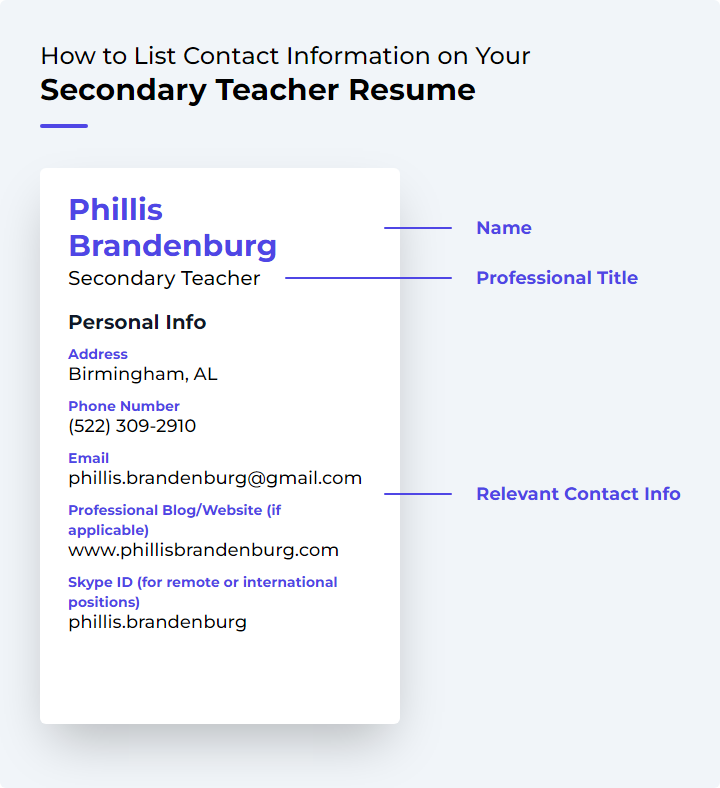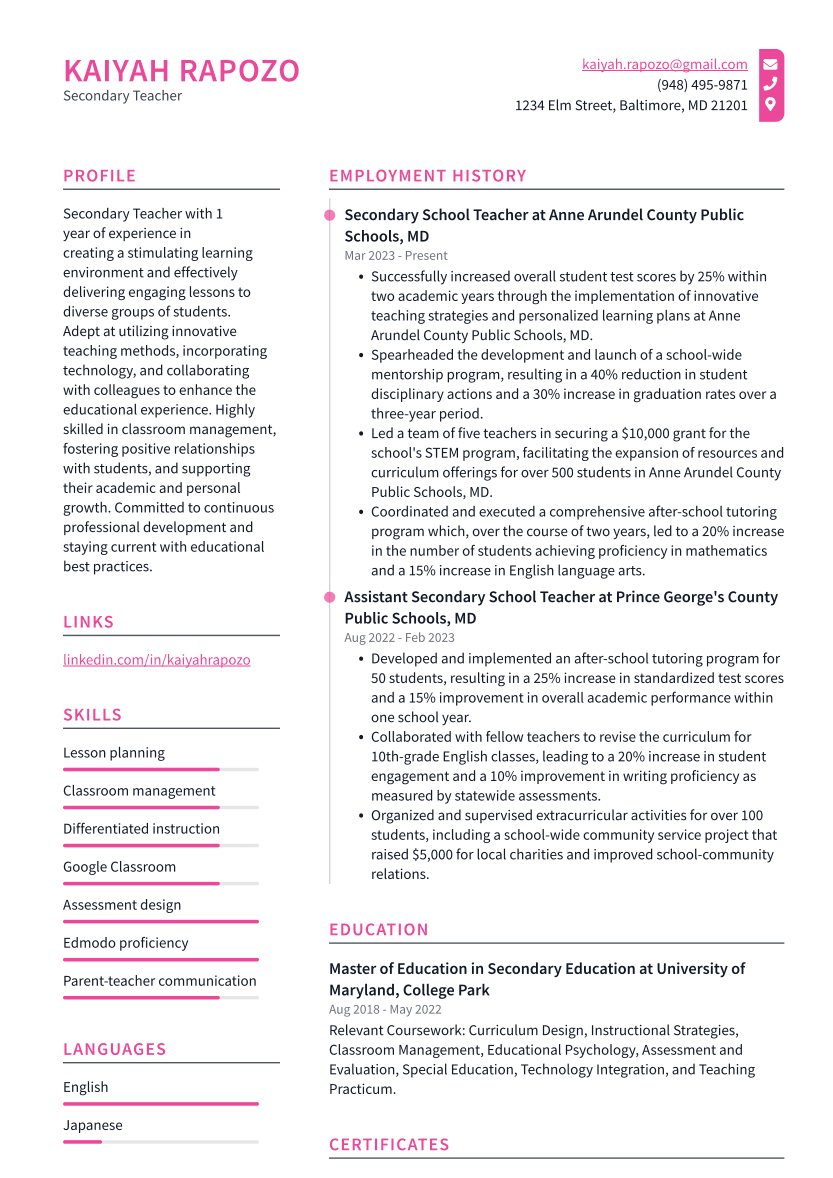Secondary Teacher Resume Examples
Writing a great secondary teacher resume is important because it is one of the first things a potential employer will see when they are considering you for a position. It is your opportunity to make a good first impression and sell yourself as the best candidate for the job.
Create your resume
Select from 7 professional resume templates
If you're looking for inspiration when it comes to drafting your own secondary teacher resume, look no further than the samples below. These resumes will help you highlight your experience and qualifications in the most effective way possible, giving you the best chance of landing the secondary teacher job you're after.
Essential Components of a Secondary Teacher's Resume
A secondary teacher's resume is a critical document that showcases their skills, qualifications, and experience in the field of education. It serves as the initial point of contact with potential employers and plays a pivotal role in securing interviews and job opportunities. An effective resume highlights a candidate's suitability for a teaching position and demonstrates their potential to contribute positively to a school community.
In this guide, we'll delve into the essential elements of a secondary teacher's resume, offering insights into each section's significance, what it should contain, and tips for making your resume stand out.
1. Contact Information
Ensure your resume includes your contact information, which is particularly crucial for a secondary teacher. This enables employers to reach out to you for further discussions or interviews.

Place your contact information prominently at the top of your resume. It should typically consist of your full name, phone number, and a professional email address. Consider adding a LinkedIn profile or professional website if relevant, but keep this section concise and avoid including personal details unrelated to your professional qualifications.
- Indicate your willingness to relocate if applying for positions in other cities or states.
- If open to remote work, which has become more common post-COVID-19, mention this as well.
Accuracy and currency in your contact details are imperative; even the most impressive qualifications are moot if employers cannot contact you.
2. Objective Statement
The "Objective Statement" is a brief but impactful introduction to your professional goals and teaching philosophy. Positioned just below your contact information, it should articulate your teaching objectives, strengths, and alignment with the position you're seeking. Tailoring this statement to each job application demonstrates your understanding of the employer's needs and your commitment to the role.
A compelling objective statement can capture the attention of hiring managers by conveying your passion for teaching and your dedication to student success. Keep it concise, no more than two sentences, and packed with relevant information to make a strong first impression.
For instance, a science teacher might write: "Passionate and seasoned Science Teacher eager to apply my expertise in experimental design and scientific analysis to inspire students in a dynamic high school environment."
Remember, the objective statement should not only showcase your skills but also reflect your commitment to fostering students' academic growth.
- Highlight Your Skills: Emphasize abilities pertinent to the job you're applying for.
- Customize Your Statement: Adapt your objective to each specific job description.
- Show Your Passion: Express your enthusiasm for teaching and dedication to student achievement.
Related: Top Secondary Teacher Resume Objective Examples
3. Education and Certifications
Educational Background: Start with your most recent degree and list previous ones in reverse chronological order. Include the institution's name, location, graduation date, and degree obtained. If you hold a Master's Degree in Education or another advanced degree, highlight this prominently.
Teaching License: Detail your teaching credentials, including the type of license, subject area, grade level, and the state of certification. This is crucial information for employers verifying your qualifications to teach.
Additional Certifications: If you possess specialized certifications, such as Special Education or TESOL, include these to showcase your broader skill set.
Professional Development: Mention any relevant courses or workshops you've attended to demonstrate your commitment to continuous professional growth.
Ensure this section is more than a list; use it to emphasize your qualifications and dedication to teaching. Present the information clearly, using bullet points for readability, and verify that all details are accurate and up-to-date.
Related: Secondary Teacher Certifications
4. Teaching Experience
Teaching Experience is a cornerstone of a secondary teacher's resume, providing insight into your practical skills and expertise. It's not enough to list the schools where you've worked; you must also highlight your achievements and responsibilities using action verbs and concrete examples.
Detail your experience with lesson planning, classroom management, student assessment, and involvement in special programs or initiatives. If you've worked with diverse student populations or in special education, include these experiences as well.
Emphasize any technological proficiency, such as familiarity with learning management systems or digital grading tools, as these are increasingly important in modern education.
Quantify your accomplishments where possible, and mention any leadership roles you've held, such as coordinating school events or mentoring new teachers.
The Teaching Experience section should not only list your past roles but also demonstrate your effectiveness and ability to foster a positive learning environment.
5. Skills and Proficiencies
The "Skills and Proficiencies" section is a showcase of your capabilities that extend beyond your educational and professional history. It's essential to list both hard skills, such as subject matter expertise and technological competencies, and soft skills, which include interpersonal abilities like communication, leadership, and adaptability.
Highlighting language skills is also beneficial, particularly in diverse educational settings.
Customization Tips:
- Align this section with the job description, ensuring that the competencies sought by the employer are reflected in your resume.
- Only list skills that you genuinely possess and can demonstrate during an interview.
Related: Secondary Teacher Skills: Definition and Examples
6. Awards and Achievements
The "Awards and Achievements" section is a testament to your excellence and commitment in the field of education. Include both internal recognitions and notable awards from professional organizations or educational bodies.
Detail the nature of each award, the awarding entity, and the context of the recognition. Academic honors, such as graduating with distinction or obtaining advanced certifications, should also be featured here.
Focus on awards and achievements that are directly related to your teaching career to underscore your effectiveness as an educator.
7. References
The "References" section provides potential employers with third-party validation of your skills and professional conduct. Choose references who can attest to your teaching abilities and professional demeanor, such as former supervisors, colleagues, or parents of students.
Always obtain permission before listing someone as a reference and provide their name, job title, affiliation, contact information, and your relationship to them.
Remember, references are typically requested by the employer during the latter stages of the hiring process, so provide them when asked rather than including them on your initial resume.
Well-chosen references can significantly enhance your application by offering an external perspective on your professional capabilities within an educational environment.
